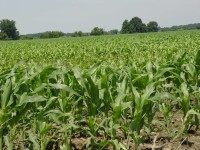The Nitrogen Outlook For 2012

The outlook for the North American crop nutrient supplier industry remains very favorable. In its January update, USDA projected a U.S. ending corn stocks-to-use ratio of 6.7% for the 2011 marketing year, which would be the second lowest level in 40 years. This tight balance is expected to support high corn prices for 2012, providing growers a compelling incentive to plant corn — and to apply nitrogen-based crop nutrients.
U.S. farm income was a record high in 2011 and is expected to remain near this level in 2012. CF Industries, one of the largest North American based producers of nitrogen fertilizers, anticipates that U.S. growers will plant 93.5 million acres of corn in 2012, an increase of 1.6 million acres over 2011.
A Look At The Dynamics
To understand the outlook for nitrogen fertilizers, it is important to understand the market dynamics that played out in 2011 and set the stage for solid momentum heading into 2012. Annual U.S. demand for nitrogen fertilizers was the second highest on record in 2011 due to the strong crop plantings, especially of corn. The year began with a very positive outlook as the industry prepared for spring planting. Manufacturers and dealers alike expected strong spring plantings, and dealers were intent on exiting the planting season with low inventories.
However, excessive precipitation throughout the U.S. Corn Belt severely delayed planting for most crops, especially in the Eastern Corn Belt. These delays, combined with flooding in other areas, led to lower planted acreage than expected. With prolonged flooding and snarled transportation logistics, the challenges of moving crop nutrients by barge or rail during spring were significant and required a high degree of flexibility and ingenuity to keep plant nutrients flowing.
Despite these significant weather issues, corn planted acreage exceeded 90 million acres for just the second time, supporting a strong and extended ammonia and urea ammonium nitrate (UAN) solution sidedress application season. As a result, nitrogen fertilizer demand was abnormally strong into the summer months. Following a very wet spring, hot summer weather accelerated crop development, erasing the delays caused by late planting and setting the stage for normal harvest timing, but also reducing yields for many crops.
The resulting high crop prices allowed growers to enjoy record farm income, which contributed to robust fall fertilizer application despite global macroeconomic concerns. Fieldwork was delayed by dry weather in areas such as southern Minnesota and Iowa. In addition, the severe drought in the Southern Plains resulted in reduced fall application there. The rest of the Corn Belt enjoyed good weather and nitrogen fertilizer demand remained very high, especially for fall-applied ammonia.
Crop prices declined slightly in the fourth quarter of 2011 due to a combination of macroeconomic concerns and an increase in grain stock estimates.
Continuing The Trend
In all, 2011 proved to be an excellent year for agriculture, and this momentum should continue as we enter 2012. Nitrogen producers are gearing up for a strong spring. As of mid-January 2012, CF Industries’ forecast for corn plantings is 93.5 million acres, which would tie the record set in 2007. A drought in Argentina and southern Brazil led to a recovery in crop prices beginning in mid-December, especially for corn and soybeans. Large plantings and strong crop prices are expected to support nitrogen fertilizer demand near record high levels in 2012.
Global fertilizer trade will continue to have a bearing on domestic nitrogen markets during 2012 as the U.S. imports approximately 50 percent of its nitrogen requirements. Some key drivers in the global market include Chinese exports, India’s import demand and new production capacity. During 2011, Chinese nitrogen and phosphate fertilizer export tariffs became very restrictive, and this is expected to continue into 2012, reducing Chinese exports to the world market and lowering global supply. At the same time, demand in India has been growing at a pace of approximately 7% a year. This likely will continue unless agriculture policies providing significant subsidies to farmers are revised. These two factors have been instrumental in a short global nitrogen fertilizer balance the last two years and are expected to continue into 2012 as agriculture and domestic fertilizer demand in these countries continue to grow.
In 2012, a number of large scale manufacturing projects are expected to begin production in the Middle East and Africa. This will take some pressure off of other nitrogen fertilizer suppliers in meeting rising global demand. The net effect of these new nitrogen sources likely will be a balanced market by mid-year, but this outcome will depend on the timing of large projects, which almost always experience start-up delays due to operational difficulties. Even before delays, typical ramp-up and delivery times will prevent most new supplies from reaching the U.S. market until after the spring season.
In order to meet increased demand for nitrogen fertilizers in North America in 2012 and beyond, CF Industries is investing in its logistics systems and production capabilities. Process improvements at our terminals in Cowden, IL, and Mount Vernon, IL, will increase ammonia supply and load out rates during the peak spring and fall periods. Other terminal upgrades also are planned over the next year. As previously announced, we will invest up to $1.5 billion in new ammonia and/or product upgrading capacity within North America over the next four years to ensure a steady flow of our products to dealers and ultimately growers who will use them to help feed the world’s growing population.






